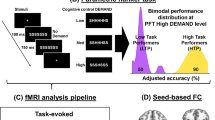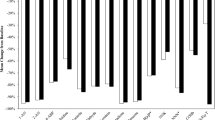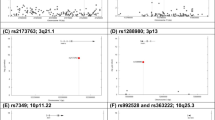Abstract
Modeling intra-individual fluctuations in estradiol and progesterone may provide unique insight into the effects of ovarian hormones on the etiology and treatment of nicotine dependence. This randomized placebo-controlled laboratory study tested the independent and interactive effects of intra-individual ovarian hormone variation and nicotine on suppression of tobacco withdrawal symptoms and smoking behavior. Female smokers randomized to 21 mg nicotine (TNP; n=37) or placebo (PBO; n=43) transdermal patch following overnight abstinence completed three sessions occurring during hormonally distinct menstrual cycle phases. At each session, participants provided saliva for hormone assays and completed repeated self-report measures (ie, tobacco withdrawal symptoms, smoking urge, and negative affect (NA)) followed by an analog smoking reinstatement task for which participants could earn money to delay smoking and subsequently purchase cigarettes to smoke. Higher (vs lower) progesterone levels were associated with greater reductions in NA. Higher (vs lower) progesterone levels and progesterone to estradiol ratios were associated with reducing smoking urges over time to a greater extent with TNP compared to PBO. There was an interaction between Patch and estradiol on NA. With TNP, higher-than-usual estradiol was associated with greater decreases in NA. However with PBO, lower-than-usual estradiol was associated with greater decreases in NA. These results suggest that the effects of TNP on mood- and smoking-related outcomes may vary depending on the ovarian hormone levels.
Similar content being viewed by others
Log in or create a free account to read this content
Gain free access to this article, as well as selected content from this journal and more on nature.com
or
References
Albert K, Pruessner J, Newhouse P (2015). Estradiol levels modulate brain activity and negative responses to psychosocial stress across the menstrual cycle. Psychoneuroendocrinology 59: 14–24.
Choe JK, Khan-Dawood FS, Dawood MY (1983). Progesterone and estradiol in the saliva and plasma during the menstrual cycle. Am J Obstet Gynecol 147: 557–562.
Cox LS, Tiffany ST, Christen AG (2001). Evaluation of the brief questionnaire of smoking urges (QSU-brief) in laboratory and clinical settings. Nicotine Tob Res 3: 7–16.
DeVito EE, Herman AI, Waters AJ, Valentine GW, Sofuoglu M (2014). Subjective, physiological, and cognitive responses to intravenous nicotine: effects of sex and menstrual cycle phase. Neuropsychopharmacology 39: 1431–1440.
Enders CK, Tofighi D (2007). Centering predictor variables in cross-sectional multilevel models: a new look at an old issue. Psychol Methods 12: 121–138.
Engman J, Linnman C, Van Dijk KR, Milad MR (2016). Amygdala subnuclei resting-state functional connectivity sex and estrogen differences. Psychoneuroendocrinology 63: 34–42.
Fehring RJ, Schneider M, Raviele K (2006). Variability in the phases of the menstrual cycle. J Obstet Gynecol Neonatal Nurs 35: 376–384.
Franklin TR, Allen SS (2009). Influence of menstrual cycle phase on smoking cessation treatment outcome: a hypothesis regarding the discordant findings in the literature. Addiction 104: 1941–1942.
Gilbert DG, Izetelny A, Radtke R, Hammersley J, Rabinovich NE, Jameson TR et al (2005). Dopamine receptor (DRD2) genotype-dependent effects of nicotine on attention and distraction during rapid visual information processing. Nicotine Tob Res 7: 361–379.
Goletiani NV, Siegel AJ, Lukas SE, Hudson JI (2015). The effects of smoked nicotine on measures of subjective States and hypothalamic-pituitary-adrenal axis hormones in women during the follicular and luteal phases of the menstrual cycle. J Addict Med 9: 195–203.
Heatherton TF, Kozlowski LT, Frecker RC, Fagerstrom KO (1991). The Fagerstrom Test for Nicotine Dependence: a revision of the Fagerstrom Tolerance Questionnaire. Br J Addict 86: 1119–1127.
Hedeker D, Mermelstein RJ, Demirtas H (2012). Modeling between-subject and within-subject variances in ecological momentary assessment data using mixed-effects location scale models. Stat Med 31: 3328–3336.
Henningsson S, Madsen KH, Pinborg A, Heede M, Knudsen GM, Siebner HR et al (2015). Role of emotional processing in depressive responses to sex-hormone manipulation: a pharmacological fMRI study. Translational psychiatry 5: e688.
Hughes JR, Hatsukami D (1986). Signs and symptoms of tobacco withdrawal. Arch Gen Psychiatry 43: 289–294.
Japuntich SJ, Leventhal AM, Piper ME, Bolt DM, Roberts LJ, Fiore MC et al (2011). Smoker characteristics and smoking-cessation milestones. Am J Prev Med 40: 286–294.
Leeman RF, O'Malley SS, White MA, McKee SA (2010). Nicotine and food deprivation decrease the ability to resist smoking. Psychopharmacology (Berl) 212: 25–32.
Leventhal AM, Waters AJ, Boyd S, Moolchan ET, Lerman C, Pickworth WB (2007). Gender differences in acute tobacco withdrawal: effects on subjective, cognitive, and physiological measures. Exp Clin Psychopharmacol 15: 21–36.
Leventhal AM, Waters AJ, Moolchan ET, Heishman SJ, Pickworth WB (2010). A quantitative analysis of subjective, cognitive, and physiological manifestations of the acute tobacco abstinence syndrome. Addict Behav 35: 1120–1130.
Lynch WJ, Roth ME, Carroll ME (2002). Biological basis of sex differences in drug abuse: preclinical and clinical studies. Psychopharmacology (Berl) 164: 121–137.
Lynch WJ, Sofuoglu M (2010). Role of progesterone in nicotine addiction: evidence from initiation to relapse. Exp Clin Psychopharmacol 18: 451–461.
McKee SA (2009). Developing human laboratory models of smoking lapse behavior for medication screening. Addict Biol 14: 99–107.
McKee SA, Krishnan-Sarin S, Shi J, Mase T, O'Malley SS (2006). Modeling the effect of alcohol on smoking lapse behavior. Psychopharmacology (Berl) 189: 201–210.
McKee SA, Smith PH, Kaufman M, Mazure CM, Weinberger AH (2015). Sex differences in varenicline efficacy for smoking cessation: a meta-analysis. Nicotine Tob Res 18: 1002–1011.
Milivojevic V, Sinha R, Morgan PT, Sofuoglu M, Fox HC (2014). Effects of endogenous and exogenous progesterone on emotional intelligence in cocaine-dependent men and women who also abuse alcohol. Hum Psychopharmacol 29: 589–598.
Mumford SL, Steiner AZ, Pollack AZ, Perkins NJ, Filiberto AC, Albert PS et al (2012). The utility of menstrual cycle length as an indicator of cumulative hormonal exposure. J Clin Endocrinol Metab 97: E1871–E1879.
Pang RD, Leventhal AM (2013). Sex differences in negative affect and lapse behavior during acute tobacco abstinence: a laboratory study. Exp Clin Psychopharmacol 21: 269–276.
Pang RD, Zvolensky MJ, Schmidt NB, Leventhal AM (2015). Gender differences in negative reinforcement smoking expectancies. Nicotine Tob Res 17: 750–754.
Payne TJ, Smith PO, McCracken LM, McSherry WC, Antony MM (1994). Assessing nicotine dependence: a comparison of the Fagerstrom Tolerance Questionnaire (FTQ) with the Fagerstrom Test for Nicotine Dependence (FTND) in a clinical sample. Addict Behav 19: 307–317.
Riad-Fahmy D, Read GF, Walker RF (1983). Salivary steroid assays for assessing variation in endocrine activity. J Steroid Biochem 19: 265–272.
Saladin ME, McClure EA, Baker NL, Carpenter MJ, Ramakrishnan V, Hartwell KJ et al (2015). Increasing progesterone levels are associated with smoking abstinence among free-cycling women smokers who receive brief pharmacotherapy. Nicotine Tob Res 17: 398–406.
Schiller CE, Saladin ME, Gray KM, Hartwell KJ, Carpenter MJ (2012). Association between ovarian hormones and smoking behavior in women. Exp Clin Psychopharmacol 20: 251–257.
Shirtcliff EA, Granger DA, Schwartz EB, Curran MJ, Booth A, Overman WH (2000). Assessing estradiol in biobehavioral studies using saliva and blood spots: simple radioimmunoassay protocols, reliability, and comparative validity. Horm Behav 38: 137–147.
Smith PH, Kasza KA, Hyland A, Fong GT, Borland R, Brady K et al (2015). Gender differences in medication use and cigarette smoking cessation: results from the International Tobacco Control Four Country Survey. Nicotine Tob Res 17: 463–472.
Sofuoglu M, Babb DA, Hatsukami DK (2001). Progesterone treatment during the early follicular phase of the menstrual cycle: effects on smoking behavior in women. Pharmacol Biochem Behav 69: 299–304.
Sofuoglu M, Mouratidis M, Mooney M (2011). Progesterone improves cognitive performance and attenuates smoking urges in abstinent smokers. Psychoneuroendocrinology 36: 123–132.
Toll BA, Schepis TS, O'Malley SS, McKee SA, Krishnan-Sarin S (2007). Subjective reactivity to the first cigarette of the day as a predictor of smoking relapse: a preliminary study. Drug Alcohol Depend 89: 302–305.
Watson D, Clark LA, Tellegen A (1988) Development and Validation of Brief Measures of Positive and Negative Affect: The PANAS Scales Vol 54. American Psychological Association: USA., pp 1063–1070.
Weinberger AH, Smith PH, Allen SS, Cosgrove KP, Saladin ME, Gray KM et al (2015). Systematic and meta-analytic review of research examining the impact of menstrual cycle phase and ovarian hormones on smoking and cessation. Nicotine Tob Res 17: 407–421.
Wetherill RR, Franklin TR, Allen SS (2016). Ovarian hormones, menstrual cycle phase, and smoking: a review with recommendations for future studies. Curr addict rep 3: 1–8.
Worthman CM, Stallings JF, Hofman LF (1990). Sensitive salivary estradiol assay for monitoring ovarian function. Clin Chem 36: 1769–1773.
Wu PC, Hsueh KC, Mar GY, Hsueh SC, Tu MS, McRobbie H et al (2015). Gender differences in outcome of an attempt to stop smoking among smokers attending a smoking cessation clinic in Taiwan: 3-year follow-up study. Eval Health Prof 39: 317–325.
Author information
Authors and Affiliations
Corresponding author
Additional information
Supplementary Information accompanies the paper on the Neuropsychopharmacology website
Supplementary information
PowerPoint slides
Rights and permissions
About this article
Cite this article
Pang, R., Liautaud, M., Kirkpatrick, M. et al. Ovarian Hormones and Transdermal Nicotine Administration Independently and Synergistically Suppress Tobacco Withdrawal Symptoms and Smoking Reinstatement in the Human Laboratory. Neuropsychopharmacol. 43, 828–837 (2018). https://doi.org/10.1038/npp.2017.216
Received:
Revised:
Accepted:
Published:
Issue date:
DOI: https://doi.org/10.1038/npp.2017.216



